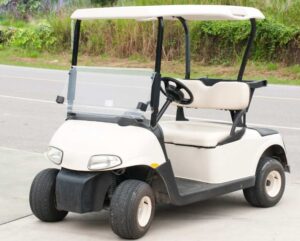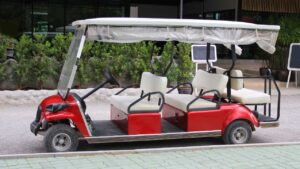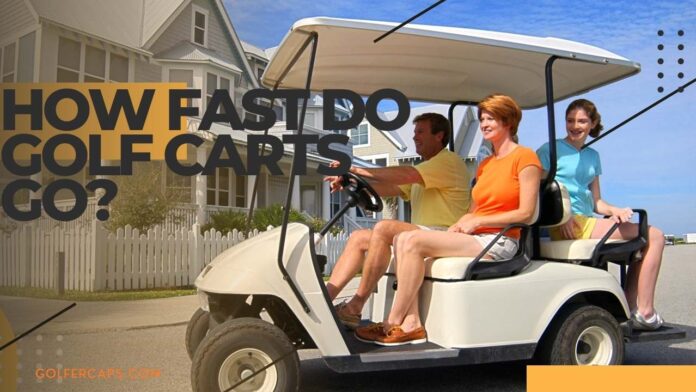Golf carts are ubiquitous sights on golf courses worldwide, facilitating the movement of players and equipment across expansive greens. While their primary purpose is golf-related transportation, they also find applications in various other settings, from resorts and retirement communities to industrial facilities and recreational parks. Understanding their speed capabilities is crucial for both efficient use and safety considerations.
How Fast Do Golf Carts Go?

The average golf cart, without any modifications, will travel at speeds between 12 and 14 miles per hour. There isn’t a big difference in speed between electric and gas-powered carts in this range.
It’s important to remember that some golf courses might have their speed limits, which are usually lower than the maximum unrestricted speed. Also, in some areas, golf carts are considered street-legal and can be driven on roads with lower speed limits (around 25 mph). However, these street-legal carts typically need to have additional safety features like headlights, taillights, and seatbelts.
How fast do electric golf carts go?

Electric golf carts typically travel at speeds between 12 and 15 miles per hour (mph) in their stock configuration. Here’s a breakdown:
- Average speed: 12-14 mph
- Some models: Up to 25 mph
There are a couple of factors that can influence an electric golf cart’s speed:
- Motor power: Carts with stronger motors can reach higher speeds, especially those with 48V systems compared to 36V.
- Terrain: Hills and uneven surfaces require the motor to work harder, reducing speed.
It’s important to remember that exceeding the designed speed can be dangerous and may void your warranty. Always prioritize safety and follow the manufacturer’s recommendations for your specific cart.
How fast do gas golf carts go?

Gas golf carts generally have a similar speed range to electric carts, averaging around 12 to 14 miles per hour (mph) in unmodified form. While some sources claim they might reach 18-20 mph [source], they typically don’t offer the same level of speed upgrades as electric carts. Here’s a comparison:
- Average speed: Similar to electric (12-14 mph)
- Potential top speed (unmodified): Might be slightly higher than electric (up to 18-20 mph depending on the source)
- Upgradability for speed: Less modification potential compared to electric carts
Here’s a quick note on factors affecting speed:
- Engine power: A more powerful engine in a gas cart could offer a slight edge in top speed.
- Terrain: Similar to electric carts, hills will slow you down due to the engine needing to work harder.
Just like with electric carts, exceeding the intended speed can be risky and might void your warranty. It’s always best to prioritize safety and follow the manufacturer’s recommendations for operating your gas golf cart.
How fast will a 48V golf cart go?

A 48V golf cart’s top speed depends on a few things, but typically they can reach speeds of around 20 mph on flat terrain. Here’s a breakdown of the influencing factors:
- Motor: A higher-performance motor can provide more power and allow for faster speeds, potentially reaching 25-30 mph.
- Terrain: Hills will slow you down because the motor has to work harder.
- Battery size: A larger battery pack can provide more power for climbing hills or maintaining speed for longer trips.
It’s important to note that modifying a golf cart for higher speeds can be dangerous. The cart may not be designed to handle the extra stress, and exceeding the governor settings can void your warranty. Always follow the manufacturer’s recommendations for safe operation.
Read also: How much is golf cart insurance?
Factors Affecting Golf Cart Speed
Several factors influence the speed of a golf cart. The most significant ones include engine power, terrain, weight capacity, and battery life (for electric carts). A combination of these factors determines how fast a golf cart can travel under different conditions.
Types of Golf Carts
There are primarily two types of golf carts: gas-powered and electric-powered. Gas-powered carts rely on internal combustion engines fueled by gasoline, while electric carts utilize rechargeable batteries to power electric motors. Each type has its advantages and limitations, including speed capabilities.
Speed Range of Golf Carts
The maximum speed of a golf cart depends on its type and model. Gas-powered carts typically have higher top speeds compared to electric ones. On average, gas-powered carts can reach speeds of 15 to 25 miles per hour (24 to 40 kilometers per hour), while electric carts usually have a maximum speed ranging from 12 to 20 miles per hour (19 to 32 kilometers per hour).
Regulations and Restrictions
Golf carts are subject to various regulations and restrictions, particularly on golf courses and public roads. Golf course regulations often impose speed limits to ensure the safety of players and pedestrians. Additionally, local authorities may enforce speed restrictions for golf carts used on public streets and pathways.
Modifications to Increase Speed

Modifying a golf cart to increase its speed beyond factory settings is a common desire among enthusiasts seeking improved performance. While it’s possible to enhance speed through various aftermarket modifications, it’s crucial to approach these modifications with careful consideration of safety, legal compliance, and the vehicle’s overall integrity.
1. Engine Upgrades:
One of the most straightforward methods to boost a gas-powered golf cart’s speed is by upgrading its engine. Replacing the stock engine with a higher-powered or performance-oriented model can provide a significant increase in horsepower, enabling the cart to achieve higher speeds more efficiently. However, engine upgrades should be accompanied by adjustments to other components, such as the transmission and fuel delivery system, to ensure compatibility and optimal performance.
2. Controller Adjustments (Electric Carts):
For electric-powered golf carts, the speed is primarily controlled by the vehicle’s electronic controller, which regulates power delivery to the motor. Modifying the controller settings or installing a high-performance controller can result in a noticeable increase in speed. However, it’s essential to consider the cart’s battery capacity and motor capabilities to prevent overheating or premature wear caused by excessive strain.
3. Gear Ratio Modifications:
Changing the gear ratio of a golf cart’s transmission can also affect its speed performance. By adjusting the gear ratio to favor higher speeds, the cart can achieve greater top-end velocity without sacrificing torque or acceleration. Gear ratio modifications may involve replacing gears or installing a different transmission altogether, depending on the cart’s design and compatibility.
4. High-Performance Tires:
Upgrading to high-performance tires designed for increased traction and reduced rolling resistance can improve a golf cart’s speed and handling characteristics. Low-profile tires with firmer sidewalls and specialized tread patterns can enhance stability at higher speeds and optimize the cart’s overall efficiency. However, it’s essential to ensure that tire upgrades are compatible with the cart’s suspension system and wheel specifications to avoid clearance issues or handling problems.
5. Aerodynamic Enhancements:
While golf carts may not reach speeds comparable to automobiles, aerodynamic improvements can still have a noticeable impact on their speed and efficiency. Installing aerodynamic accessories such as windshields, spoilers, or fairings can reduce air resistance and drag, allowing the cart to move more effortlessly through the air at higher speeds. Additionally, removing unnecessary accessories or streamlining the cart’s design can further enhance its aerodynamic performance.
6. Weight Reduction:
Reducing the overall weight of the golf cart can improve its acceleration and top speed by reducing the amount of energy required to propel the vehicle. Removing excess accessories, cargo, or unnecessary components can help shed unnecessary pounds and optimize the cart’s power-to-weight ratio. However, it’s essential to maintain a balance between weight reduction and structural integrity to ensure the cart remains safe and reliable.
7. Performance Tuning:
Fine-tuning the vehicle’s engine, transmission, and electronic systems through performance tuning can optimize their operation for increased speed and responsiveness. This may involve adjusting fuel and ignition timing, optimizing air intake and exhaust systems, and fine-tuning electronic parameters to maximize power output and efficiency. Performance tuning should be performed by experienced professionals familiar with the specific requirements and limitations of golf cart engines and drivetrains.
Read also: How Much Does a Golf Cart Weigh?
Safety Concerns
When it comes to golf carts, safety should always be a top priority. While these vehicles may not reach the speeds of traditional automobiles, they still pose risks, especially when operated irresponsibly or in hazardous conditions. Understanding and addressing safety concerns is essential for ensuring a safe and enjoyable experience for both passengers and pedestrians.
1. Speed Limits:
One of the most critical safety considerations for golf carts is adhering to posted speed limits. Whether on the golf course or public roads, obeying speed restrictions helps mitigate the risk of accidents and collisions. Excessive speed can compromise control, especially on uneven terrain or tight turns, increasing the likelihood of rollovers or collisions with obstacles.
2. Seat Belts and Restraints:
While golf carts may not be equipped with traditional automotive safety features like airbags, seat belts can still provide vital protection in the event of a crash or sudden stop. Ensuring that all occupants are properly secured with seat belts or restraints reduces the risk of ejection or injury during sudden maneuvers or accidents.
3. Braking Systems:
Effective braking systems are essential for maintaining control and stopping safely, particularly when traveling at higher speeds or navigating steep inclines. Regular maintenance and inspection of brake components, including pads, rotors, and hydraulic systems, are necessary to ensure optimal performance and responsiveness.
4. Visibility:
Visibility is crucial for safe operation, both for the driver of the golf cart and other road users. Proper lighting, including headlights, taillights, and turn signals, enhances visibility, especially during low-light conditions or inclement weather. Additionally, keeping windows, mirrors, and windshields clean and unobstructed improves situational awareness and reduces the risk of collisions.
5. Terrain Awareness:
Golf carts are designed for use on relatively flat and smooth surfaces, such as golf courses or paved pathways. However, they may encounter a variety of terrain types, including hills, slopes, and rough terrain. Maintaining awareness of terrain conditions and adjusting driving behavior accordingly helps prevent accidents and minimizes the risk of rollovers or loss of control.
6. Passenger Capacity:
Exceeding the recommended passenger capacity of a golf cart can compromise stability and increase the risk of accidents. Overloading the vehicle with passengers or cargo can strain the suspension and tires, negatively impacting handling and braking performance. Adhering to weight limits and distributing weight evenly within the vehicle helps maintain stability and control.
7. Operator Responsibility:
Ultimately, the safety of a golf cart depends largely on the competence and responsibility of its operator. Drivers should be familiar with the vehicle’s controls and operation, as well as applicable laws and regulations governing its use. Avoiding distractions, such as using mobile devices or consuming alcohol, while operating a golf cart is crucial for maintaining focus and reacting quickly to changing conditions.
Benefits of Different Speeds

Golf carts offer varying speeds to cater to different needs and preferences, each providing unique benefits depending on the situation. Whether cruising leisurely around a golf course or navigating through busy streets, the ability to adjust speed offers several advantages that enhance efficiency, convenience, and overall enjoyment.
1. Leisurely Cruising:
Lower speeds are ideal for leisurely cruising, allowing passengers to enjoy the scenery and surroundings without feeling rushed. Whether exploring a golf course, resort, or residential community, a leisurely pace encourages relaxation and enhances the overall experience. Slow, scenic drives also provide opportunities for socializing with fellow passengers or observing wildlife and natural landscapes.
2. Enhanced Safety:
Moderate speeds promote safety by providing drivers with more time to react to obstacles, pedestrians, and other vehicles. Maintaining a controlled pace reduces the risk of accidents and collisions, especially in crowded or unfamiliar environments. Lower speeds also minimize the severity of impacts in the event of a crash, reducing the likelihood of injuries to occupants and bystanders.
3. Efficient Transport:
Moderate to higher speeds offer efficient transportation, allowing users to reach their destinations quickly and conveniently. Whether commuting within a gated community, resort complex, or industrial facility, increased speeds shorten travel times and improve productivity. Efficient transport is especially valuable for completing tasks or running errands promptly, enhancing overall efficiency and convenience.
4. Time Savings:
Higher speeds translate to time savings, particularly when covering longer distances or traveling between distant points of interest. Whether crossing expansive golf courses or navigating through sprawling resort complexes, faster speeds reduce travel time and increase accessibility to various amenities and facilities. Time savings are especially beneficial for maximizing leisure time or completing activities within limited schedules.
5. Improved Accessibility:
Faster speeds enhance accessibility by expanding the range of destinations that can be reached within a given time frame. Whether accessing remote areas of a golf course or exploring expansive resort grounds, increased speeds broaden opportunities for exploration and discovery. Improved accessibility ensures that users can fully experience and enjoy all available amenities and attractions, enhancing overall satisfaction and enjoyment.
6. Increased Productivity:
Higher speeds promote productivity by enabling users to accomplish more within a limited period. Whether performing maintenance tasks on a golf course or transporting goods within an industrial facility, faster speeds streamline operations and facilitate efficient workflow. Increased productivity enhances overall efficiency and contributes to the successful completion of tasks and objectives.
7. Flexibility and Versatility:
The ability to adjust speeds provides flexibility and versatility in adapting to changing conditions and requirements. Whether navigating crowded pathways or traversing hilly terrain, variable speeds allow users to tailor their driving behavior to suit specific challenges and environments. Flexibility and versatility ensure that golf carts remain adaptable to a wide range of scenarios and usage scenarios, enhancing their overall utility and effectiveness.
Read also: How Much Are Golf Carts?
Comparison with Other Vehicles
Compared to regular cars or utility vehicles, golf carts generally have lower top speeds. However, their compact size and maneuverability make them well-suited for specific tasks, such as navigating narrow pathways or transporting goods within restricted areas.
Eco-Friendly Aspect
With increasing concerns about environmental sustainability, electric-powered golf carts offer a greener alternative to their gas-powered counterparts. By running on rechargeable batteries, electric carts produce zero emissions during operation, reducing their carbon footprint and contributing to cleaner air in outdoor environments.
Common Misconceptions
Despite their versatility and practicality, golf carts are sometimes subject to misconceptions regarding their speed capabilities. While they may not match the speed of conventional vehicles, they provide valuable transportation solutions for a variety of applications, emphasizing safety and efficiency over sheer velocity.
Conclusion
In conclusion, the speed of golf carts varies depending on several factors, including the type of cart, terrain conditions, and regulatory restrictions. While they may not rival the speed of traditional vehicles, golf carts offer valuable mobility solutions for diverse settings, emphasizing safety, efficiency, and environmental responsibility.
FAQs:
- Are golf carts street-legal?
- While regulations vary by location, many jurisdictions allow golf carts on designated roads with specific requirements such as lights, signals, and speed restrictions.
- Can I modify my golf cart to go faster?
- Yes, but it’s essential to consider safety implications and legal restrictions before making any modifications. Consult with a professional to ensure compliance with regulations.
- Do electric golf carts have the same speed as gas-powered ones?
- Electric carts typically have slightly lower maximum speeds compared to gas-powered ones due to differences in power delivery and motor efficiency.
- What is the average lifespan of a golf cart battery?
- The lifespan of a golf cart battery varies depending on usage, maintenance, and environmental factors. On average, batteries may last between 4 to 6 years before requiring replacement.
- Are there speed limits on golf courses?
- Yes, most golf courses enforce speed limits for carts to ensure the safety of players and pedestrians. Speed limits typically range from 5 to 15 miles per hour (8 to 24 kilometers per hour), depending on course conditions and local regulations.



